







Volkswagen was established in 1937 by the German Labour Front (Deutsche Arbeitsfront) in Berlin. In the early 1930s, cars were a luxury – most Germans could afford nothing more elaborate than a motorcycle and only one German out of 50 owned a car. Seeking a potential new market, some car makers began independent "people's car" projects – the Mercedes 170H, BMW 3/15, Adler AutoBahn, Steyr 55, and Hanomag 1.3L, among others.
The growing trend was not nascent; Béla Barényi, a pioneering automotive engineer, is credited as already having conceived the basic design during the mid-1920s. Josef Ganz developed the Standard Superior (going as far as advertising it as the "German Volkswagen"). In Germany, the company Hanomag mass-produced the 2/10 PS "Kommissbrot", a small, cheap rear-engined car, from 1925 to 1928. Also, in Czechoslovakia, the Hans Ledwinka's penned Tatra T77, a very popular car amongst the German elite, was becoming smaller and more affordable at each revision. Ferdinand Porsche, a well-known designer for high-end vehicles and race cars, had been trying for years to get a manufacturer interested in a small car suitable for a family. He built a car named the "Volksauto" from the ground up in 1933, using many popular ideas and several of his own, putting together a car with an air-cooled rear engine, torsion bar suspension, and a "beetle" shape, the front bonnet rounded for better aerodynamics (necessary as it had a small engine).

1932 type12
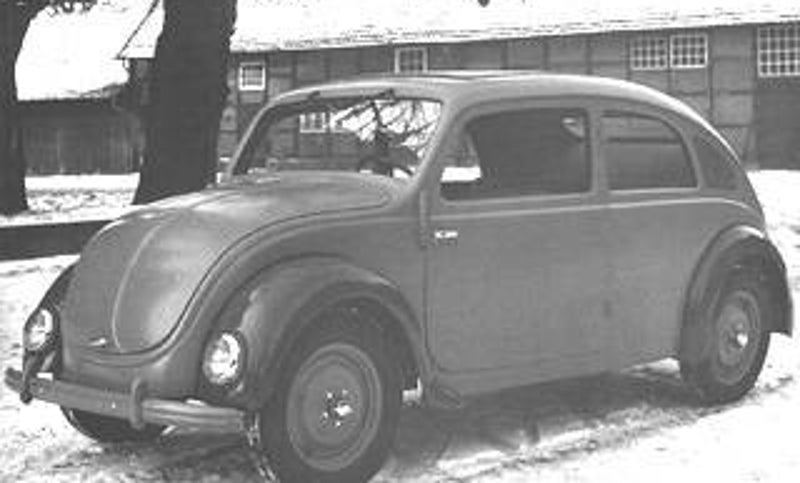
1933 type32

1936 type60

kdf
In 1934, with many of the above projects still in development or early stages of production, Adolf Hitler became involved, ordering the production of a basic vehicle capable of transporting two adults and three children at 100 km/h. He wanted a car every German family would be able to afford. The "People's Car" would be available to citizens of the Third Reich through a savings plan at 990 RM (US$396 in 1938 dollars)—about the price of a small motorcycle (the average income being around 32 RM a week).
It soon became apparent that private industry could not turn out a car for only 990 RM. Thus, Hitler chose to sponsor an all-new, state-owned factory using Ferdinand Porsche's design (with some of Hitler's design suggestions, including an air-cooled engine so nothing could freeze). The intention was that every German family could buy the car through a savings scheme ("Fünf Mark die Woche musst du sparen, willst du im eigenen Wagen fahren" – "Five Marks a week you must set aside, if in your own car you wish to ride"), which around 336,000 people eventually paid into. However, the project was not commercially viable, and only government support was able to keep it afloat.
Prototypes of the car called the "KdF-Wagen" (German: Kraft durch Freude – "Strength through Joy") appeared from 1938 onwards (the first cars had been produced in Stuttgart). The car already had its distinctive round shape and air-cooled, flat-four, rear-mounted engine. The VW car was just one of many KdF programs, which included things such as tours and outings. The prefix Volks— ("People's") was not just applied to cars, but also to other products in Germany; the "Volksempfänger" radio receiver for instance. On 28 May 1937, Gesellschaft zur Vorbereitung des Deutschen Volkswagens mbH ("Company for the Preparation of the German Volkswagen Ltd."), or Gezuvor for short, was established by the Deutsche Arbeitsfront in Berlin. More than a year later, on 16 September 1938, it was renamed to Volkswagenwerk GmbH.
Erwin Komenda, the longstanding Auto Union chief designer, part of Ferdinand Porsche's hand-picked team, developed the car body of the prototype, which was recognisably the Beetle known today. It was one of the first cars designed with the aid of a wind tunnel—a method used for German aircraft design since the early 1920s. The car designs were put through rigorous tests and achieved a record-breaking million miles of testing before being deemed finished.
The construction of the new factory started in May 1938 in the new town of "Stadt des KdF-Wagens" (renamed Wolfsburg after the war), which had been purpose-built for the factory workers. This factory had only produced a handful of cars by the time war started in 1939. None were actually delivered to any holder of the completed saving stamp books, though one Type 1 Cabriolet was presented to Hitler on 20 April 1944 (his 55th birthday).



The Volkswagen was sold to German workers on an installment plan, where buyers of the car made payments and posted stamps in a stamp-savings book, which, when full, would be redeemed for the car. Due to the shift of wartime production, no private citizen ever received a "Kdf-Wagen", though after the war, Volkswagen did give some customers a 200 DM discount for their stamp-books. The Beetle factory was then primarily converted to produce the Kübelwagen, the German equivalent of the Jeep. The few Beetles that were produced went to the diplomatic corps and military officials.
type 1
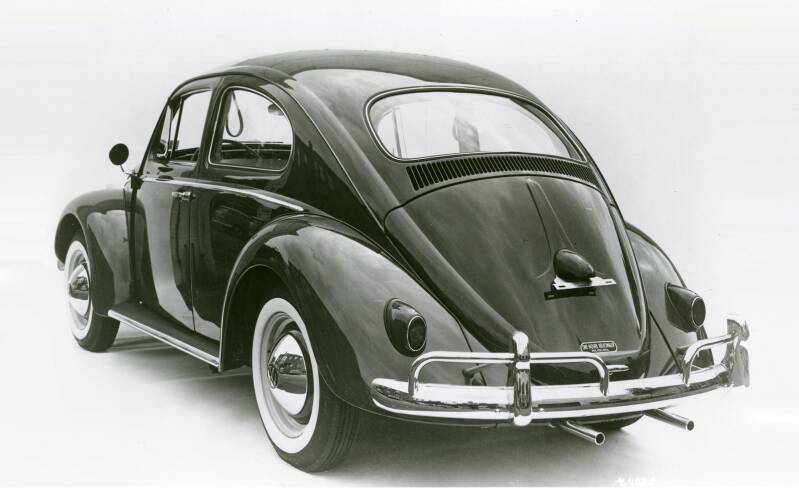
1938-2003

1947

1950

1956

1966
After WWII the re-opening of the factory was largely accredited to British Army officer Major Ivan Hirst. Hirst persuaded the British military to order 20,000 cars, and by March 1946 the factory was producing 1,000 cars a month (in Army khaki, under the name Volkswagen Type 1), which Hirst said "was the limit set by the availability of materials". During this period, the car reverted to its original name of Volkswagen and the town was renamed Wolfsburg. The first 1,785 Type 1s were made in 1945.
After initially building mostly Beetles for the British military, in 1947 production transitioned to purely civilian Beetles, for the first time featuring chromed bumpers, hubcaps, and body and running board trim. Aside from some remaining military production, civilian output reached almost 9,000 units in 1947, and for 1948 total production increased to 19,244 cars. The late 1940s Beetles still had an understressed 1131 cc engine with just 25 horsepower, but it could effortlessly maintain cruising at the car's 60-mile-per-hour (97 km/h) top speed. This was already an enlarged engine, compared to the finalized pre-war design, and in some export markets, these early civilian models were therefore labeled the Type 11.

1971

1975

1980

1984
Though extremely successful in the 1960s, experiencing its greatest sales growth in North America between 1960 and 1965, the Beetle was increasingly faced with stiff competition from more modern designs globally.. VW introduced other models to supplement the Beetle throughout the 1960s; the Type 3, Type 4, and the NSU-based and larger K70. None of these models, aimed at more upscale markets, achieved the level of success of the Beetle. The over-reliance on a single model, now in decline, meant that Volkswagen was in financial crisis by 1974. It needed German government funding to produce the Beetle's replacement.

1990

1993

2001

2003
On 17 February 1972 Beetle No. 15,007,034 was produced, surpassing total production of the previous record holder, the Ford Model T. By 1973, total production was over 16 million, and by 23 June 1992, over 21 million had been produced. By 2002, over 21 million Type 1s had been produced, but by 2003, annual production had dropped to 30,000 from a peak of 1.3 million in 1971. VW announced the end of production in June 2003, citing decreasing demand, and the final original Type 1 VW Beetle (No. 21,529,464) rolled off the production line at Puebla, Mexico, on 30 July 2003, 65 years after its original launch. This last Beetle, nicknamed El Rey (Spanish for "The King" after a legendary Mexican song by José Alfredo Jiménez) was delivered to the company's museum in Wolfsburg, Germany.

standard superior
The Standard Superior was an automobile, produced from 1933 to 1935 by Standard Fahrzeugfabrik of Ludwigsburg, Germany, founded by motorcycle maker Wilhelm Gutbrod and unrelated to the Standard Motor Company of England. These small cars were designed according to the patents by Josef Ganz and featured rear-mounted two-stroke engines. In the first half of 1932, Wilhelm Gutbrod, the President of the Standard Fahrzeugfabrik, came into contact with German engineer Josef Ganz. Ganz had been working on a small car design since the early 1920s and had so far built two prototypes, one for Ardie in 1930 and one for Adler in 1931, called the Maikäfer (May Beetle).

With the Ardie-Ganz, Adler Maikäfer and Standard Superior cars, as well as his progressive writings and promotion of the concept of a Volkswagen (people's car) in Motor-Kritik magazine since the 1920s, Josef Ganz is claimed by some to have had input into the Volkswagen Beetle. These cars had some of features of the later Volkswagen Beetle, such as the tubular chassis, rear-mounted engine and independent wheel suspension with swing axles. While the Volkswagen Beetle was produced in its millions after World War Two, the name of Josef Ganz was largely forgotten. In 2004, Dutch journalist Paul Schilperoord started researching the life and work of Josef Ganz, and in 2011 he published The Extraordinary Life of Josef Ganz: The Jewish Engineer Behind Hitler's Volkswagen.
kübelwagen
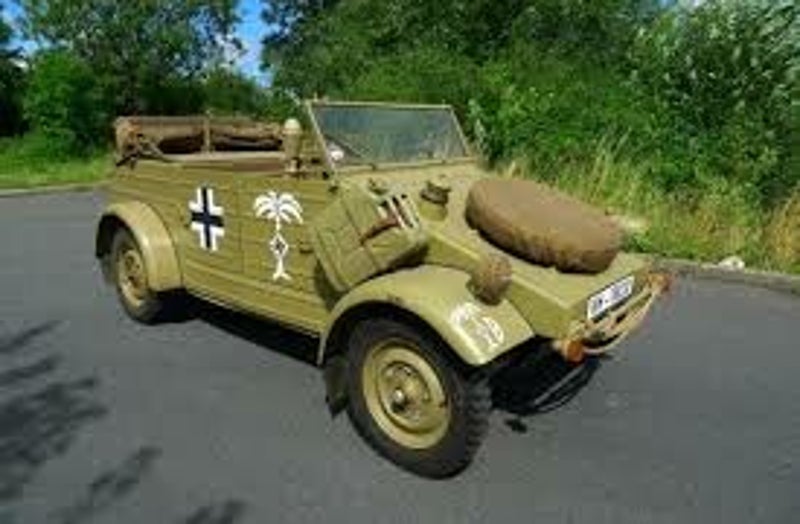
1940-1945

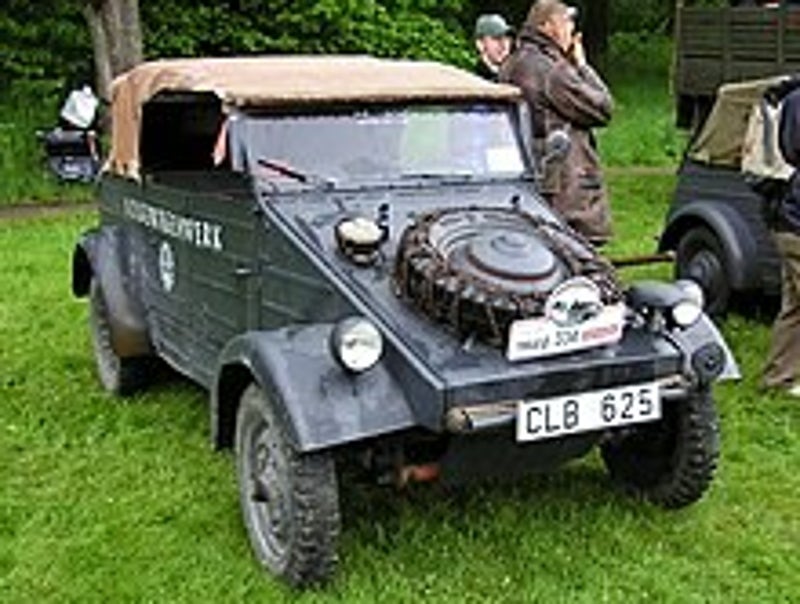

The Volkswagen Kübelwagen (listen (help·info)) (a back-formation as literally, 'tub' car), was a light military vehicle designed by Ferdinand Porsche and built by Volkswagen during World War II for use by the German military (both Wehrmacht and Waffen-SS). Based heavily on the Volkswagen Beetle, it was prototyped as the Type 62, but following improvements entered production as the Type 82.
Kübelwagen is a contraction of Kübelsitzwagen, meaning 'bucket-seat car' because all German light military vehicles that had no doors were fitted with bucket seats to prevent passengers from falling out. This body style had first been developed by Karosseriefabrik N. Trutz [de] in 1923. The first Porsche Type 62 test vehicles had no doors and were therefore fitted with bucket seats as Kübelsitzwagen, that was later shortened to Kübelwagen. Mercedes-Benz, Opel, and Tatra also built Kübelsitzwagen.
Its rolling chassis and mechanics were built at Stadt des KdF-Wagens (renamed Wolfsburg after 1945), and its body was built by U.S.-owned firm Ambi Budd Presswerke in Berlin. The Kübelwagen's role as a light military vehicle made it the German equivalent to the Allied Willys MB/Ford GP "Jeep" and the GAZ-67.
dannenhauer

1950-1957



Dannenhauer & Stauss was founded by Gotthilf Dannenhauer, a German coachbuilder. He had been employed by Karosseriewerk Reutter based in Stuttgart. Whilst there, he was communicating with Volkswagen before World War II. From 1950 to 1957 Reutter manufactured about 100 convertibles, mostly based on the Volkswagen Beetle. The sales price was 8,892 DM. The body was handmade by tapping metal sheets on a template. The doors were made in a pressing shop. Other companies like DKW were supplied. When in 1955 the Karmann Ghia was mass-produced, the company could no longer compete, and its product was discontinued. The amount of production was limited, but precise numbers are uncertain. Changing their business model to rebuilding vehicle bodies allowed the company to survive at the address in Augustenstraße, Stuttgart where Reutter had been.
About 15 of the DKW Monza cars were made by Dannenhauer & Stauss. Ostensibly, a grand total of about 80 of the DKW Monza cars were made, albeit by different companies.
karmann ghia
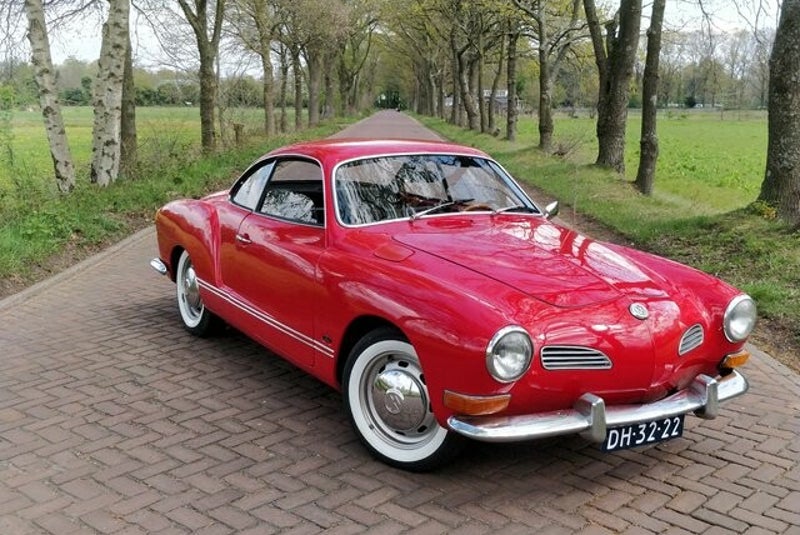
1955-1974


1957-1974

1966 type 34
The Volkswagen Karmann Ghia is a sports car marketed in 2+2 coupe (1955–1974) and 2+2 convertible (1957–1974) body styles by Volkswagen. Internally designated the Type 14, the Karmann Ghia combined the chassis and mechanicals of the Type 1 (Beetle) with styling by Italy's Carrozzeria Ghia and hand-built bodywork by German coachbuilding house Karmann. More than 445,000 Karmann Ghias were produced in Germany over the car's production life, not including the Type 34 variant. Volkswagen do Brasil (Volkswagen Brasil) produced 41,600 Type 34s in Brazil for South America between 1962 and 1975.
Long noted for its exterior styling, the Karmann Ghia was designed with input from numerous individuals at Carrozzeria Ghia and was strongly influenced by Virgil Exner's work, though all of its designers passed without a definitive individual styling attribution.
In contrast to the Beetle's machine-welded body with bolt-on fenders, the Karmann Ghia's body panels were butt-welded, hand-shaped, and smoothed with English pewter in a time-consuming process commensurate with higher-end manufacturers, resulting in the Karmann Ghia's higher price.
In late 1974 the car was superseded by the Golf-based Scirocco.
type 3

1961-1973 fastback


notchback

variant
The Volkswagen Type 3 is a compact car that was manufactured and marketed by Volkswagen from 1961 to 1973. Introduced at the 1961 Frankfurt Motor Show, (IAA), the Type 3 was marketed as the Volkswagen 1500 and later as the Volkswagen 1600, in three body styles: two-door Notchback, Fastback and Variant, the latter marketed as the 'Squareback' in the United States.
The Type 3 diversified Volkswagen's product range beyond the existing models – the Type 1 Beetle, Type 14 Karmann Ghia, Type 2 (Bus) – while retaining several of the Beetle's key engineering principles, notably the air-cooled rear-engine, rear-wheel drive layout and all-round torsion bar suspension on the same 2,400 mm wheelbase. The concept of the Type 3 was to be more of a family car than the Beetle, offering more passenger and luggage space and a larger engine.
The Type 3 followed the Type 1 Beetle, utilizing a low-profile version of Volkswagen's rear-engined, 4-cylinder air-cooled engine, as well as body-on-chassis construction (the body bolts to a frame that includes the floor pan), retaining the same wheelbase – but featuring ponton (slab sided) styling, in contrast to the Type 1's articulated fenders and running boards. VW finalized the design by 1959 with prototypes ready for testing by 1960. Secrecy was such that even at the 1960 Geneva Auto Show, VW denied they were readying a new design. In 1961 VW announced the new line as the "VW 1500". While the Type 3 was a more modern design, it never reached the same level of popularity as the Beetle. As Volkswagen started to produce front-wheel-drive water-cooled designs, production ended in 1973 at the Wolfsburg plant.
type 181

1968-1983



The Volkswagen Type 181 is a two-wheel drive, four-door, convertible, manufactured and marketed by Volkswagen from 1968 to 1983. Originally developed for the West German Army, the Type 181 also entered the civilian market as the Kurierwagen (“courier car”) in West Germany, the Trekker (RHD Type 182) in the United Kingdom, the Thing in the United States (1973–74), the Safari in Mexico and South America, and Pescaccia in Italy. Civilian sales ended after model year 1980.
Manufactured in Wolfsburg, West Germany (1968–74), Hannover, West Germany (1974–83), Puebla, Mexico (1970–80), and Jakarta, Indonesia (1973–80), the Type 181 shared its mechanicals with Volkswagen's Type 1 (Beetle) and the pre-1968 Volkswagen Microbus, its floor pan with the Type 1 Karmann Ghia, and its concept with the company's Kübelwagen, which had been used by the German military during World War II.
All four doors were removable and interchangeable, the windshield folded flat, and the convertible roof could be removed for al fresco driving. The spartan interior featured vinyl covered bucket seats, painted sheet metal, drain holes and perforated rubber mats. A fiberglass hardtop and trunk-mounted auxiliary heater were offered as individual options. Civilian sales began in mainland Europe and Mexico during 1971; in the U.S. in 1972; and briefly in Britain in 1975, where it failed to sell well and was dropped fairly quickly.
type 4

1968-1972 411


1972-1974 412

412 variant
The Volkswagen Type 4 is a large family car manufactured and marketed by Volkswagen of Germany from 1968 to 1974 in two-door and four-door sedan as well as two-door station wagon body styles. The Type 4 evolved through two generations, the 411 (1968–72) and 412 series (1972–74).
Designed under the direction of Heinrich Nordhoff and introduced at the Paris Motor Show in October 1968, the 411 was Volkswagen's largest passenger vehicle with the company's largest engine – with styling credited to Carrozzeria Pininfarina, who at the time had an advisory contract with Volkswagen. The cars retained VW's trademark air-cooled, rear placement, rear-wheel drive, boxer engine with a front/rear weight distribution of 45/55% and a forward cargo storage 400 L — while also introducing design and engineering departures for the company – including a completely flat passenger area floor and suspension using control arms and MacPherson struts. Volkswagen had prototyped a notchback sedan and convertible versions of the 411, without introducing them to production.
Over its six-year production run, Volkswagen manufactured 367,728 Type 4 models, compared with 210,082 of the subsequent Volkswagen K70 with its four-year model life. In the United States, VW sold 119,627 Type 4s from 1971 to July 1974 and in Germany 119,094 cars were sold. South Africa was the 3rd biggest market for the Type 4 with 34,452 sales and the United Kingdom 4th at 13,367.
Volkswagen's last air-cooled sedans and wagons, (aside from the Brasilia which carried on until 1982) the Type 4 models were succeeded by the first generation Passat, marketed as the Dasher in the USA.
At launch, the 411 featured a 1679 cc engine with twin carburetors. The 412 replaced the 411 in August 1972 in Germany, having been restyled by designer Brooks Stevens. Halogen lights were fitted, the headlight surround was reshaped and the nose panels were redesigned. The engine capacity was raised to 1795 cc.

In 1964, Volkswagen acquired Auto Union, and in 1969, NSU Motorenwerke AG (NSU). The former company owned the historic Audi brand, which had disappeared after the Second World War. VW ultimately merged Auto Union and NSU to create the modern Audi company, and would go on to develop it as its luxury vehicle marque. The purchase of Auto Union and NSU was a pivotal point in Volkswagen's history, as both companies yielded the technological expertise that proved necessary for VW to survive when demand for its air-cooled models went into decline.
k70

1970-1975
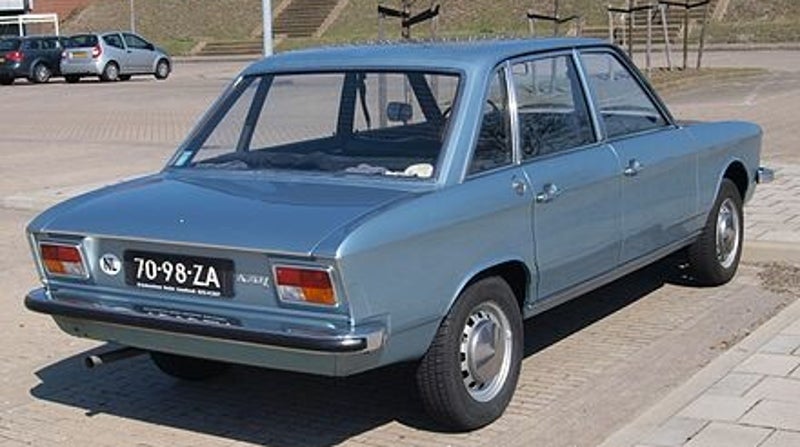


The Volkswagen K70 is a four-door, front engine, front wheel drive sedan developed by NSU and marketed from 1970–1975 by Volkswagen after its 1969 acquisition of NSU.
Designed by NSU's chief engineer Ewald Praxl and styled by Claus Luthe as a four-door sedan (and three-door wagon) to complement the NSU Ro80, the K70 would become the first Volkswagen with a front-mounted engine, water cooling and front wheel drive. Competing with VW's own 411/412 and Audi's 100, the K70 was ultimately sold only as a sedan, with 211,127 examples manufactured for model years 1970–1975.
The K70 retained NSU's naming convention, as introduced with the Ro 80 — with K denoting the German word Kolben (piston) and 70 designating an engine output of 70 PS.
Plans for the K70 launch were deferred at the last minute, with rumors that Volkswagen removed the K70 from NSU's show stand on the eve of the show. In total, 23 pre-series K70s with NSU badging were built. VW took over NSU, and during 1969 NSU was integrated with Auto Union, which Volkswagen had acquired from Daimler Benz in 1964 — in turn creating the basis of modern-day Audi. Considering the K70, with its front wheel drive and modern styling, could transform its image, VW scrapped publicity material showing the K70 badged as an NSU, and just over a year later the sedan went into production at Volkswagen's new Salzgitter plant.
sp2

1973-1976
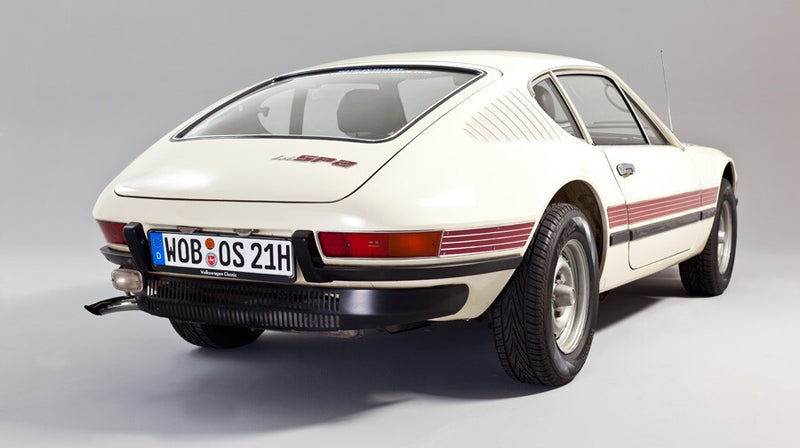
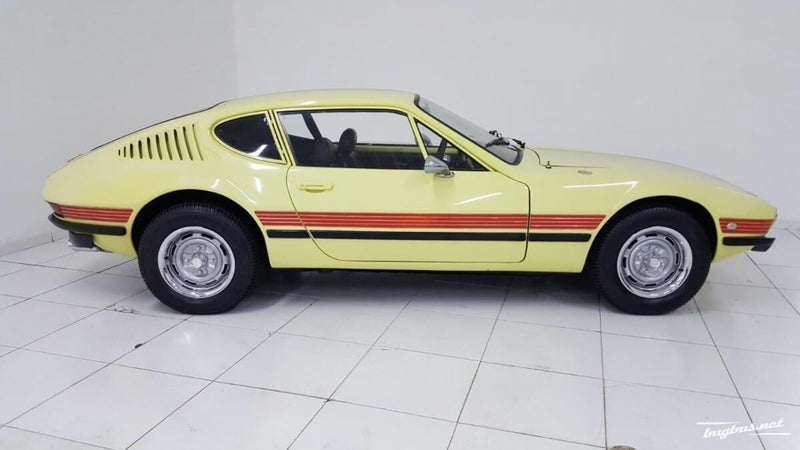
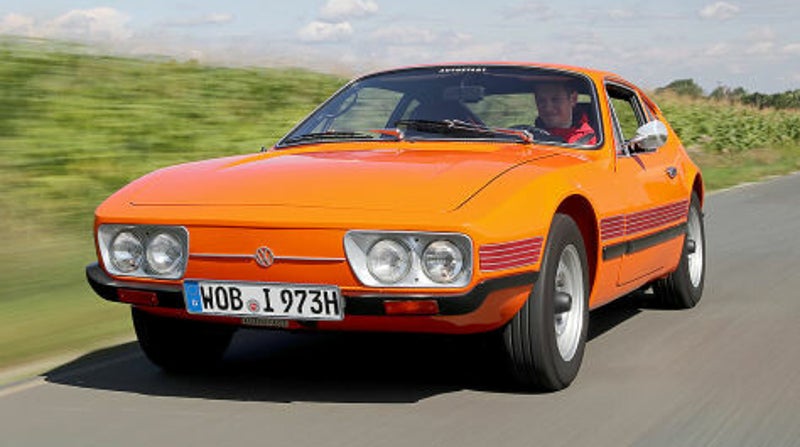
The SP2 is a sports car developed by Volkswagen do Brasil for the Brazilian market, and produced from 1972 to 1976. It is based on the Brazilian market Volkswagen Variant.
In the 1970s, the Brazilian market was closed for imports. The only sports car officially made there was the aging (and by then retired) Volkswagen Karmann Ghia, and its successor, the Karmann Ghia TC. Only independent car makers were able to fill the gap, notably Puma, Santa Matilde and Miura. The Volkswagen subsidiary in Brazil always had some degree of independence from Wolfsburg, so in 1969 they decided to start a new project of their own. They presented a prototype in 1971, but it would take another year before the car reached production.
The SP2 was built on the frame of a Variant, with the same Volkswagen air-cooled engine, but upgraded to 1,700 cc. It developed 75 hp, propelling the car from 0-100 km/h in around 17 seconds according to period tests and to a top speed of 160 km/h.
When the car was presented, it quickly drew media attention, with its many improvements over the local "air cooled" VW line, an impressive interior, its many extra features and its superb finishing. The name officially stands for "São Paulo", but locals gave it the nickname "Sem Potência", which is Portuguese for "without power".
A car named SP1 was also built, similar in almost every aspects but the engine, logo and a few trim items. However, due to its very poor performance (65 hp from a 1,600 cc engine), it was soon discontinued, after only 88 units were built. Despite being praised by critics for its looks, the SP2 failed to beat its main competitor, the Puma, in the performance category. Although they used similar engines, the fiberglass-bodied Puma was much lighter. This resulted in low sales, and the SP2 was discontinued in February 1976. In total, 10,205 units were made; 670 were exported, of which 155 went to Nigeria. Only one model was delivered to Europe, Portugal.
sirocco

1974-1981 generation I

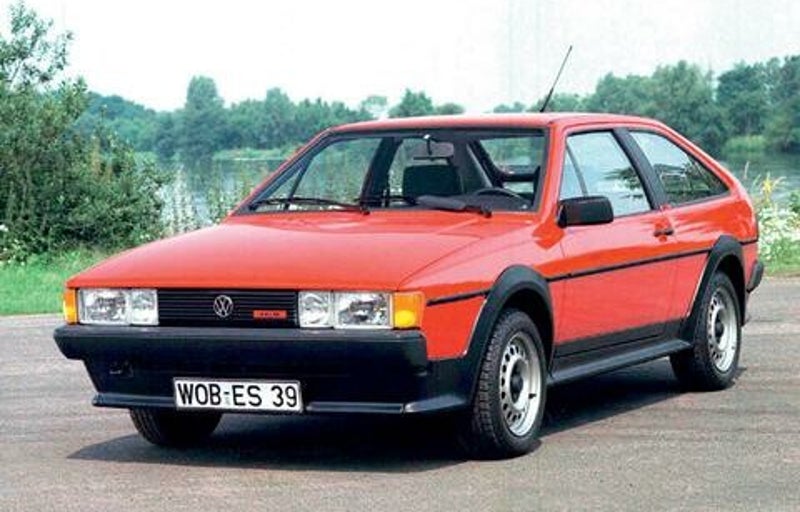
1981-1992 generation II
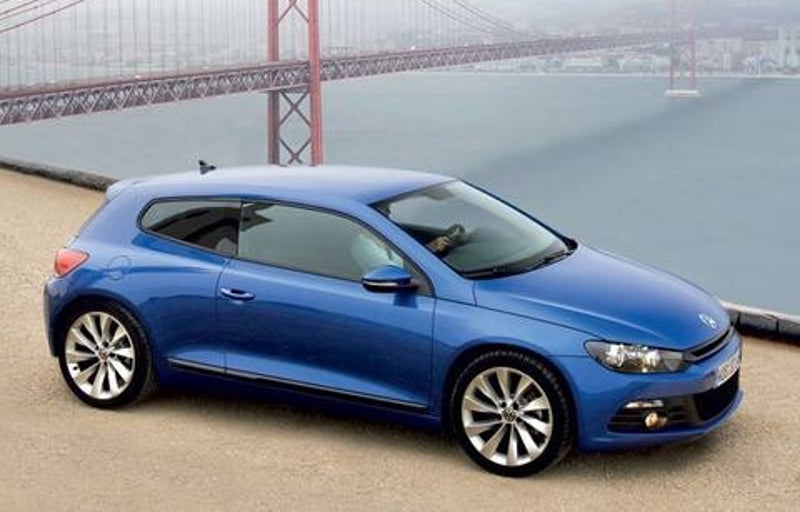
2008-2017 generation III
The Volkswagen Scirocco is a three-door, front-engine, front-wheel-drive, sport compact hatchback manufactured and marketed by Volkswagen in two generations from 1974 to 1992 and a third generation from 2008 until 2017. Production ended without a successor. The Scirocco derives its name from the Mediterranean wind.
Volkswagen began work on the car during the early 1970s as the replacement for the aging Karmann Ghia coupe, and designated it the Typ 53 internally. Although the platform of the Golf was used to underpin the new Scirocco, almost every part of the car was re-engineered in favour of a new styling (penned by Giorgetto Giugiaro) which was sleeker and sportier than that of the Golf. The Scirocco GTi entered production in the summer of 1976, while the later cult Golf GTI wasn't unveiled until the autumn of the same year.
The second generation Scirocco, still assembled on behalf of Volkswagen by Karmann of Osnabrück (in the same factory as the first generation Scirocco), was first shown in 1981. Designed by Volkswagen's own internal design team, the new car featured increased front and rear headroom, increased luggage space and a reduction in the coefficient of drag. One feature of the Type 2 was the location of the rear spoiler midway up the glass on the rear hatch. Eleven different engines were offered in the Type 2 Scirocco over the production run, although not all engines were available in all markets.
The third generation model, identified by the internal type numbers 137 or 1K8, is based on the PQ35 platform of the Golf V and was unveiled at the 2008 Geneva Motor Show. It went on sale in summer 2008 in Europe, with sales in other countries beginning early 2009. The Type 3 Scirocco won "Car of the Year 2008" from Top Gear Magazine. In April 2007, Volkswagen America vice president Adrian Hallmark claimed that Volkswagen preferred not to bring the Scirocco to North America since it could negatively affect Golf GTI sales.
corrado

1989-1995

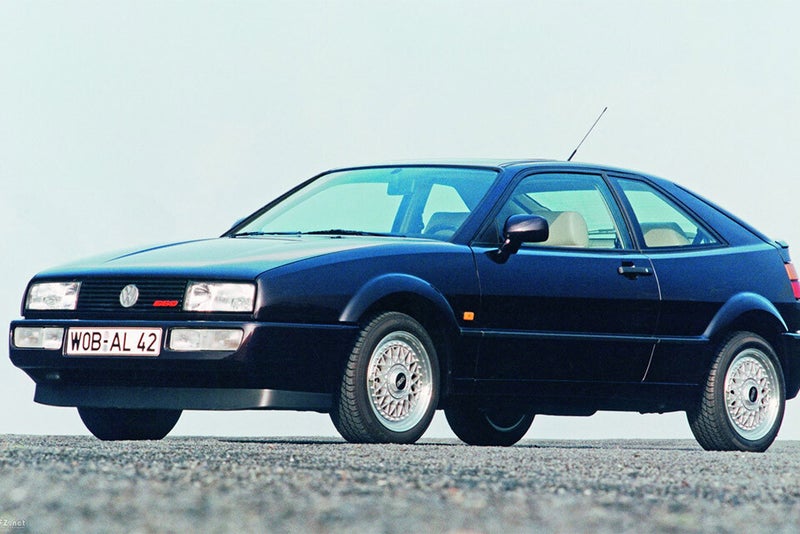

As the VW Scirocco was discontinued in 1988, VW needed to come up with a new model and such the Corrado was revealed in 1989. The Corrado had a distinctive look and was a sports coupe assembled by Karmann. Launched in the end of 1988 (three years before the end of Scirocco production), all Corrados were front-wheel drive and featured petrol engines. The Corrado debuted with two engine choices: a 1.8 litre 16-valve inline four with 136 PS and a supercharged 1.8 litre eight valve inline four, marketed as the G60 and delivering 160 PS. Later vw introduced a VR6 engine, which came in two variants: a 2.8 litre 179 bhp model for the United States and Canadian markets, and a 2.9 L producing 190 PS version for the European market.
Designed by Herbert Schäfer, the Corrado overlapped and eventually superseded Volkswagen's Scirocco model. 97,521 Corrados were manufactured over the seven year production run.
Auto Express magazine describe it as "Regarded as one of VW’s best ever drivers’ cars". The VR6 model was listed as one of the "25 Cars You Must Drive Before You Die" by the British magazine Car, and 'By far the most desirable version of the Corrado' by Auto Express.
golf
The original Golf Mk1 was a front-engined, front-wheel drive replacement for the air-cooled, rear-engined, rear-wheel drive Volkswagen Beetle. Historically, the Golf is Volkswagen's best-selling model and is among the world's top three best-selling models, with more than thirty million built as of June 2013.
Initially, most Golfs were 3-door hatchbacks. Other variants include a 5-door hatchback, estate (Variant, from 1993), convertible (Cabriolet and Cabrio, 1979–2002, Cabriolet, 2011–present), and a Golf-based saloon, called the Volkswagen Jetta, Volkswagen Vento (from 1992) or Volkswagen Bora (from 1999). The Golf has crossed from economy to high-performance market segments.
The Golf has won awards, including the World Car of the Year in 2009, with the Volkswagen Golf Mk6 and in 2013 with the Volkswagen Golf Mk7. Along with the Renault Clio and the Vauxhall Astra, the Golf is one of only three cars to have won European Car of the Year twice, in 1992 and 2013. The Volkswagen Golf has made the annual Car and Driver 10Best list multiple times. The Golf Mk7 won the Motor Trend Car of the Year award in 2015, and the Mk1 GTI also won the award in 1985.

1974 mkI
In May 1974, Volkswagen presented the first-generation Golf as a modern front-wheel-drive, long-range replacement for the Volkswagen Beetle. Later Golf variations included the Golf GTI (introduced in June 1976 with a fuel-injected 1.6-litre engine capable of 180 km/h (110 mph)), a diesel-powered version (from September 1976), the Jetta notchback saloon version (from October 1979), the Volkswagen Golf Cabriolet (from January 1980 through 1994) and a Golf-based van, the Volkswagen Caddy.
The Golf Mk1 was sold as the Volkswagen Rabbit in the United States and Canada and as the Volkswagen Caribe in Mexico.
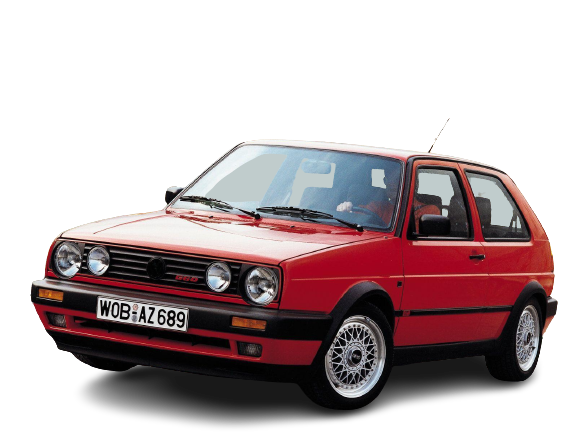
1983 mkII
September 1983 saw the introduction of the second-generation Golf (Mk2) that grew slightly in terms of wheelbase, exterior and interior dimensions, while retaining, in a more rounded form, the Mk1's overall look. Although it was available on the home market and indeed most other left-hand drive markets by the end of 1983, it was not launched in the UK until March 1984.
The Mk2 GTI featured a 1.8-litre 8-valve fuel-injected engine from its launch, with a 16-valve version capable of more than 220 km/h being introduced in 1985. In 1985, the first Golfs with four-wheel-drive (Golf Syncro) went on sale.

1991 mkIII
The third-generation Golf (Mk3) made its home-market debut in August 1991 and again grew slightly in comparison with its immediate predecessor, while its wheelbase remained unchanged.
New engines included the first Turbocharged Direct Injection (TD) diesel engine in a Golf, and a narrow-angle 2.8-litre VR6 engine.
The notchback version, called VW Vento, was presented in January 1992. It was European Car of the Year for 1992, ahead of the new Citroën ZX and General Motors' new Opel Astra model.

1997 mkIV
The Golf Mk4 was first introduced in August 1997, followed by a notchback version (VW Bora or, in North America, again VW Jetta) in August 1998 and a new Golf Variant (estate) in March 1999. There was no Mk4-derived Cabriolet, although the Mk3 Cabriolet received a facelift in late 1999 that consisted of bumpers, grill and headlights similar to those of the Mark IV models.
New high-performance models included the 3.2-litre VR6-engined four-wheel-drive Golf "R32" introduced in 2002, its predecessor, the 2.8-litre VR6-engined "Golf V6 4Motion" (succeeding the 2.9-litre Mk3 "Golf VR6 Syncro"), as well as the famous 1.8T (turbo) 4-cylinder used in various Volkswagen Group models.

2003 mkV
The Golf Mk5 was introduced in Europe in the autumn of 2003, reaching the UK market in early 2004. In North America, Volkswagen brought back the Rabbit nameplate when it introduced the vehicle in 2006. In Canada, the Golf is still the prevalent nameplate of the fifth generation (though both Rabbit and Golf have both been used historically). The saloon/sedan version, again widely marketed Volkswagen as the Jetta, is assembled in Germany, South Africa, as well as Mexico. It is marketed in certain markets, including European markets and Mexico as Bora.

2008 mkVI
The Mk6 Golf was designed by Volkswagen's chief designer Walter de'Silva. The design is said to be more aerodynamic, helping fuel efficiency, and is quieter than its predecessor. Following criticism of the downgraded interior trim quality of the Mk5 Golf in comparison to the Mk4, Volkswagen opted to overhaul the interior to match the quality with the Mk4 Golf, while maintaining the same user friendliness from the Mk5. The car is also cheaper to build than its predecessor; Volkswagen claims it consequently will be able to pass these savings on to the customer.[
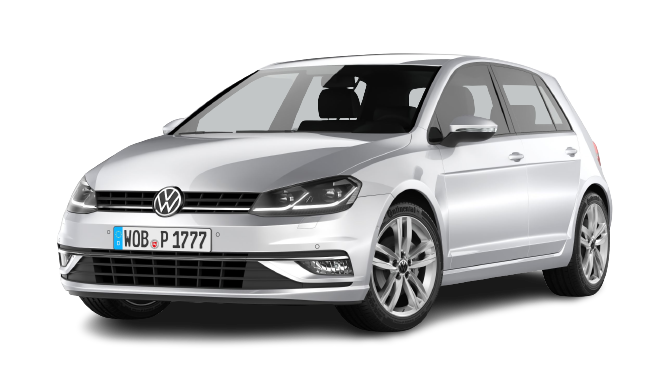
2012 mkVII
The Golf VII, Typ 5G uses the new MQB platform, shared with the third-generation Audi A3, SEAT León and Škoda Octavia. It is slightly larger than the Mk6 while managing to be approximately 100 kg lighter, depending on engine choice. The most powerful Golf in the range is the Golf R. Built as a 3 or 5 door hatchback, it is powered by a newly developed version of the 1,984 cc (2.0 L; 121.1 cu in) turbocharged EA888 petrol FSI Inline-four engine used in the latest Golf GTI (and Audi S3), but in this application producing 300 PS

2019 mkVIII
At launch, the five-door hatchback was the only model available, with the three-door hatchback having been discontinued due to poor sales. The Golf VIII's interior receives a major overhaul with an entirely digital driver's display and digital control panel. All Mk8's have advanced safety features available such as travel assist, Car2X and an oncoming vehicle while braking function, the latter two of which are the first to be used on a production Volkswagen model. Powertrain options now have three eTSI mild-hybrid and two eHybrid plug-in hybrid engines in addition to existing TSI petrol, TDI diesel and TGI compressed natural gas (CNG) options. All TSI engines with an output up to 130 PS

transporter
The Volkswagen Transporter, based on the Volkswagen Group's T platform, now in its sixth generation, refers to a series of vans produced for over 70 years and marketed worldwide. The T series is now considered an official Volkswagen Group automotive platform. and generations are sequentially named T1, T2, T3, T4, T5 and T6. Pre-dating the T platform designations, the first three generations were named Type 2, indicating their relative position to the Type 1, or Beetle. As part of the T platform, the first three generations are retroactively named T1, T2 and T3.
The Transporter is the best-selling van in history with over 12 million units sold worldwide, and it comprises a gamut of variants including vans, minivans, minibuses, pick-ups and campervans. Competitors include the Ford Transit, Toyota Hiace and Mercedes-Benz Vito.

The first generation of the Volkswagen Type 2 with the split windshield, informally called the Microbus, Splitscreen, or Splittie among modern fans, was produced from 8 March 1950 through the end of the 1967 model year. From 1950 to 1956, the T1 (not called that at the time) was built in Wolfsburg; from 1956, it was built at the completely new Transporter factory in Hanover. Like the Beetle, the first Transporters used the 1100 Volkswagen air-cooled engine, an 1131 cc , 24 bhp, air-cooled flat-four-cylinder 'boxer' engine mounted in the rear.
1950-1967 type 1

1967-1979 type 2
In late 1967, the second generation of the Volkswagen Type 2 (T2) was introduced. It was built in West Germany until 1979. In Mexico, the Volkswagen Kombi and Panel were produced from 1970 to 1994. Models before 1971 are often called the T2a (or "Early Bay"), while models after 1972 are called the T2b (or "Late Bay").
This second-generation Type 2 lost its distinctive split front windshield, and was slightly larger and considerably heavier than its predecessor. Its common nicknames are Breadloaf and Bay-window, or Loaf and Bay for short. At 1.6 L and 47 bhp, the engine was also slightly larger.
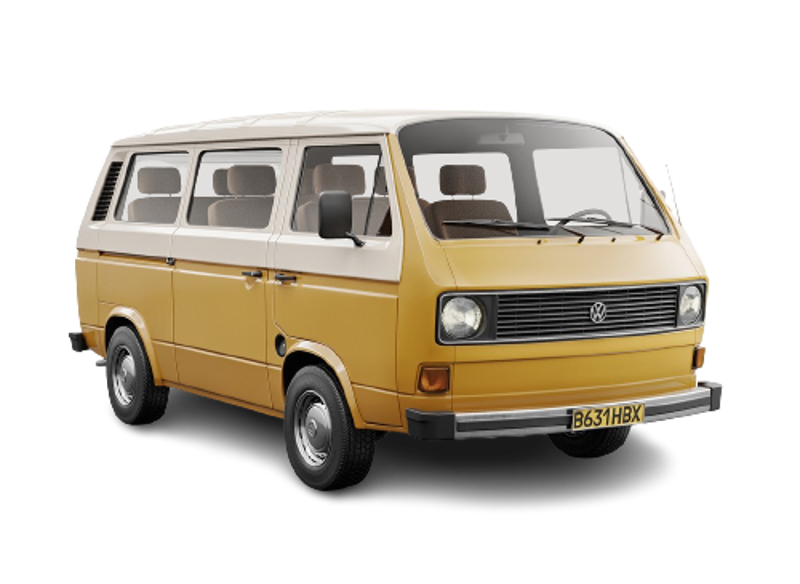
1979-1992 type3
The Volkswagen Type 2 (T3), (and occasionally T25 within the UK, but technically incorrect) or Vanagon in the United States, the T3 platform was introduced in 1979, and was one of the last new Volkswagen platforms to use an air-cooled engine. The Volkswagen air-cooled engine was phased out for a water-cooled boxer engine (still rear-mounted) in 1983. Compared to its predecessor the T2, the T3 was larger and heavier, with square corners replacing the rounded edges of the older models. The T3 is sometimes called "the wedge" by enthusiasts to differentiate it from earlier Kombis.

1990-2003 type4
For 1990, the T4 generation was released, with the model range dropping the Type 2 name in favor of the Transporter nameplate. Over 15 years after the Golf was introduced as the replacement for the Type 1 (Beetle), the Transporter range also adopted a front-engine, front-wheel drive configuration (Syncro 4WD returned as an option). Worldwide, the model range now used water-cooled, fuel-injected engines, with inline (and later VR6) engines replacing the "wasserboxer".
Through much of the world, the T4 was marketed as the Transporter, with 3-row passenger vans known as the Caravelle; the Vanagon name was used in Japan. In the United States, the T4 was marketed as the Eurovan.

2003-2015 type5
The Volkswagen Transporter T5 range is the fifth generation of Volkswagen Commercial Vehicles medium-sized light commercial vehicle and people movers.
The T5 has a more aerodynamic design. The angle of the windshield and A-pillar is less; this makes for a large dashboard and small bonnet. In June 2009, Volkswagen Commercial Vehicles announced the one-millionth T5 rolled off the production line in Hanover. T5 GP introduced in 2010. Heavily facelifted with some new power plants including the 180 bi-turbo range topper. These new engines saw the demise of the now "dirty" 5 cylinder units.

2016-2021 type 6
The new T6 launched with the old Euro 5 non-AdBlue power-plants, but is offered with a Euro 6 diesel engine with 204bhp and AdBlue. Three further Euro 6 Adblue diesel power-plants with 84ps, 102ps and 150ps are also offered.
There is some debate in the community over whether the T6 is a new model, or simply a face-lift of the T5. There are obvious external changes to the nose and tailgate, while internally there is a new dash in two different versions. Volkswagen claims refinement to ride, handling and noise levels.

2022-present type 7
In June 2021, Volkswagen unveiled the new T7 version as the "Multivan", slated to go on sale in Europe in 2022. The vehicle, built on the MQB platform, will feature a plug-in hybrid version as well as both gasoline and diesel engine options. The T6 will continue production for commercial sales.
While the Caravelle was the people-carrying derivative of VW's medium-sized Transporter van, the new model is being pitched as an all-new model which will also replace VW's Touran and Sharan MPVs

Volkswagen has always had a close relationship with Porsche, the Zuffenhausen-based sports car manufacturer founded in 1931 by Ferdinand Porsche, the original Volkswagen designer and Volkswagen company co-founder, hired by Adolf Hitler for the project. The first Porsche car, the Porsche 64 of 1938, used many components from the Volkswagen Beetle. The 1948 Porsche 356 continued using many Volkswagen components, including a tuned engine, gearbox and suspension.
The two companies continued their collaboration in 1969 to make the VW-Porsche 914 and Porsche 914-6. (The 914-6 had a 6-cylinder Porsche engine, and the standard 914 had a Volkswagen engine.) Volkswagen and Porsche would collaborate again in 1976 on the Porsche 912-E (the USA only) and the Porsche 924, which used many Audi components and was built at Audi's Neckarsulm facilities. The 924 was originally designated for AUDI. Most Porsche 944 models were built there, although they used far fewer VW components.
The Porsche Cayenne, introduced in 2002, shares its entire chassis with the Volkswagen Touareg and Audi Q7, and is built at the same Volkswagen factory in Bratislava that the other SUVs are built.
In September 2005, Porsche announced it would increase its 5% stake in Volkswagen to 20%, with the intention that the combined stakes of Porsche and the government of Lower Saxony would ensure that any hostile takeover by foreign investors would be impossible. Speculated suitors included DaimlerChrysler, BMW, and Renault. In July 2006, Porsche increased their ownership again to 25.1%.
In October 2009 however, Volkswagen announced that its percentage in Porsche would be 49.9%. On 1 March 2011, Volkswagen has finalised the purchase of Porsche Holding Salzburg (PHS), Austria's leading specialty automobile distributor.
phaeton

2002-2016 series I & II


2008 series III

2011 series IV
The Volkswagen Phaeton is a full-size luxury sedan/saloon described by Volkswagen as their "premium class" vehicle. Introduced at the 2002 Geneva Motor Show, the Phaeton was marketed worldwide. Sales in North America ended in 2006 and global sales ended in 2016. The name Phaeton derives from Phaëton, the son of Phoebus (or Helios) in Greek mythology, by way of the phaeton auto body style and the type of horse-drawn carriage that preceded it.
Production ended in March 2016 and an all-electric second generation was slated to be produced. Starting in April 2017, the Gläserne Manufaktur Dresden assembles the e-Golf instead.
The Phaeton was conceived by Ferdinand Piëch, then chairman of Volkswagen Group. Piëch wanted Volkswagen engineers to create a car that would surpass the German prestige market leaders, Mercedes-Benz and BMW. The decision to release the Phaeton was, in part, a response to Mercedes' decision to compete directly with Volkswagen in the European marketplace with the low cost A-Class and BMW with the release of the low cost BMW 3 Series Compact.
Compared to the Audi A8L 4.2 litre FSI quattro, the Phaeton is 247 kg heavier but is still competitive with the lighter A8 in most driving tests, due to the Phaeton's increased engine power (335 hp versus 330) and a shorter axle ratio (3.65:1 versus 3.32). However, the weight gives the Phaeton considerably worse acceleration and poorer fuel economy compared to the A8.
Sales of the Phaeton fell far short of expectations. Its biggest market was China, followed by South Korea. In all four generations have been made.
phaeton d2

2016
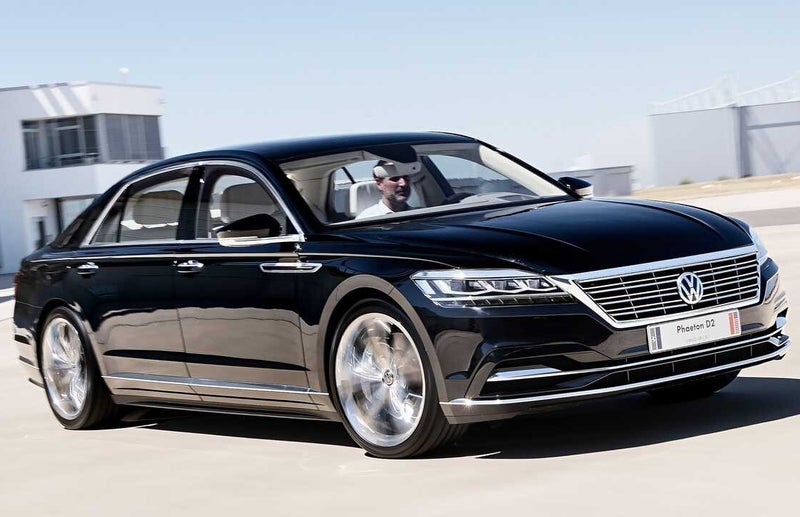
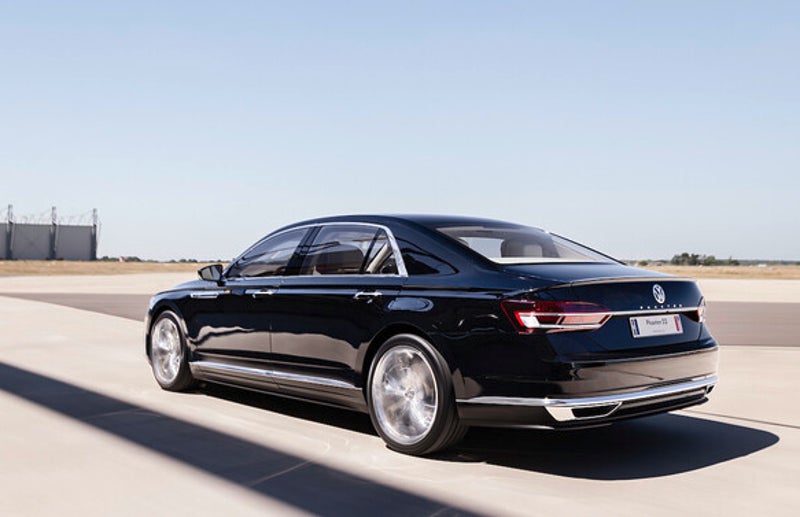
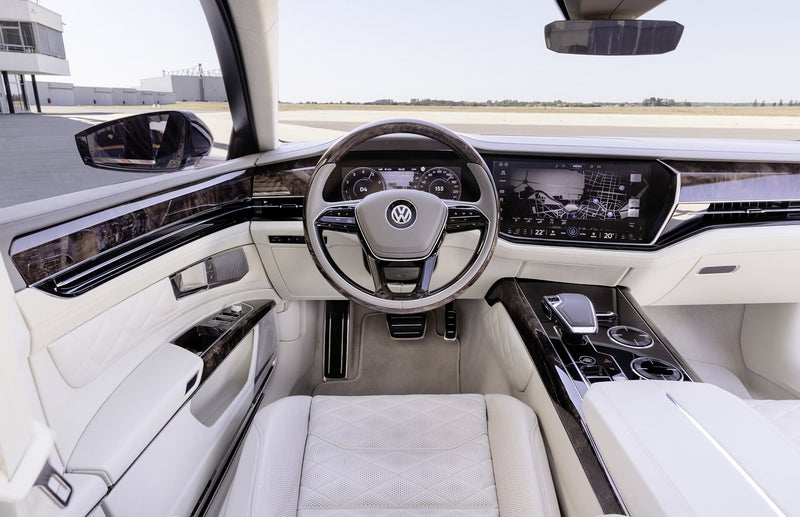
Volkswagen was considering a wide engine range for the new Phaeton, including petrol, diesel, and plug-in hybrid variants. Mind you, the second generation of the sedan would be based on the MLB architecture, making it easy to share engines with sibling models like the similarly-styled Audi A8. the flagship variant of the Phaeton would have been fitted with the glorious twin-turbo 6.0-liter W12 engine producing as much as 604 hp. The same engine is used in the Bentley Flying Spur, allowing it to accelerate from 0-100 km/h in 3.8 seconds and giving it a top speed of 333 km/h. Those figures would make the Phaeton a true sleeper, and a proper competitor for the V12-powered BMW M760i.
Finally, plans for a new Phaeton were scrapped in favour of spending more money on the electrification of the VW Group.
touareg
The Volkswagen Touareg is a mid-size luxury crossover SUV produced by German automaker Volkswagen since 2002 at the Volkswagen Bratislava Plant.
The vehicle was named after the nomadic Tuareg people, inhabitants of the Saharan interior in North Africa. As of its first generation, the Touareg was developed together with the Porsche Cayenne and the Audi Q7, sharing platforms and much technology. The vehicles were developed as unibody SUVs with independent suspension. The initial generation (2002–2010) offered five-, six-, eight-, ten- and twelve-cylinder engine choices.


2002-2010 7L
The Volkswagen Touareg (internally designated Typ 7L) was developed as a joint venture project by Porsche and the Volkswagen Group, involving the Audi and Volkswagen brands. The sports car market fluctuates and Porsche CEO Wendelin Wiedeking was looking to expand into new segments. This included marketing its first four-door vehicle. A team in Weissach, Germany, of over 300 was led by Klaus-Gerhard Wolpert developed the Volkswagen Group PL71 platform. It is shared by the VW Touareg, the Audi Q7, and the Porsche Cayenne. There are styling, equipment, performance, and technical differences between them. The Touareg and Porsche both seat five, while the Q7's stretched wheelbase accommodates a third row for seven passengers.
The Touareg comes as standard with a four-wheel drive system. It has an automatic progressively locking centre differential (with manual override), and a "low range" setting that can be activated with in-cabin controls. Options to make the vehicles more capable off-road include an available 4-wheel Adaptive Air Suspension (plus Continuous Damping Control) which can raise the car's ride height on command, and an interior switch allowing the rear differential to be manually locked.
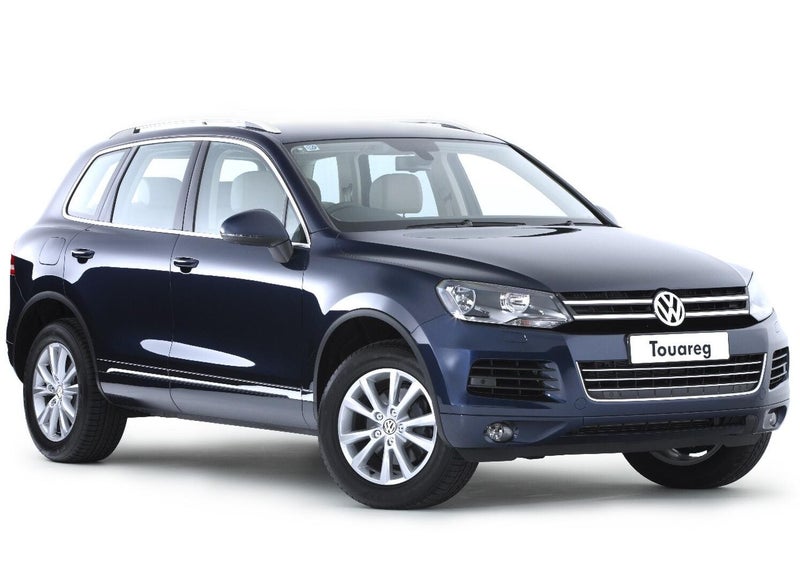
2010-2018 7P
The second generation (Typ 7P) was revealed on February 10, 2010 in Munich, and later at the 2010 Beijing International Auto Show. The new Touareg features a world first in automotive headlight technology: the "glare-free high beam"

2018- CR
The third generation Touareg will use the Volkswagen Group MLB platform like its corporate siblings, the Porsche Cayenne and Audi Q7. The third generation Touareg will emphasize fuel efficiency and will reportedly be significantly lighter than the first two generations. VW has discontinued the Touareg for sale in North America from 2017 model year onward, based on sales, and on the availability of the larger and less expensive Atlas (Teramont elsewhere) model which was specifically designed for the United States.
teramont/atlas

2017-present



2020 atlas cross sport/coupé
The Volkswagen Atlas is a mid-size crossover SUV manufactured by the German automaker Volkswagen. Up to the introduction of the China-only Talagon, the Atlas is the largest vehicle produced on the Volkswagen Group MQB platform. Developed mainly for the North American and Chinese market, the Atlas for the Americas is produced in the Chattanooga plant in Chattanooga, Tennessee, United States. The Atlas is marketed as the Volkswagen Teramont outside North America. The vehicle features a transverse mounted four-cylinder or Volkswagen's narrow angle VR6. The 2.0-liter engines are locally manufactured in China, while the VR6 engine is manufactured in Germany and shipped over to the factory in Shanghai. It was developed specifically for the Chinese market where engines above 3.0 liters are subject to heavy excise tax.
The Atlas Cross Sport (called Teramont X in China and Teramont Cross Sport in Mexico) is a smaller variation of the Atlas/Teramont. The 4.97 meter long vehicle has the same wheelbase (2.98 meters) as the three-row model, but has a lower roof and angled rear window to give it a sportier appearance and is only available with two rows of seating instead of three.
ea
EA stands for ‘Entwicklungsauftrag’, which means ‘development order’.




1963 EA128 Prototype
1955 EA47-12
1969 EA276
1972 ea272
The 1963 EA128 was Volkswagen's vision for a large luxury car. Its three-place front bench allows it to seat six, albeit somewhat intimately. Six is also the cylinder count—the EA128's 2.0 liter air-cooled horizontally-opposed engine was borrowed from the Porsche 911, which also made its debut in 1963.
Throughout the 1950s, Volkswagen was looking to move away from the Beetle. The EA47-12 was the twelfth of 15 prototypes produced by Turin coachbuilder Ghia. This prototype featured a transverse-link front axle, torsion-bar rear suspension, and a fully-synchronized transmission.
The EA276 of 1969 was an early prototype for what would eventually become the Volkswagen Golf. This prototype presaged the general shape and front-wheel-drive layout of the Golf, but its engine was the air-cooled boxer four from the Beetle. Volkswagen would later adapt the concept of a front-mounted air-cooled engine in the Brazilian-market Gol (yep, that's how it's spelled) of 1980.
To replace the rear-mounted 1600 engine the development division at Volkswagen devised the EA 272 front-wheel-drive concept at the beginning of the 1970s, on which the engine was mounted transversely between the front wheels to save space. The engine was a 1297cc four-cylinder in-line, water-cooled unit that had a power output of 55hp and able to propel the EA 272 to a top speed of 147 km/h.

Volkswagen is a market leader in China, which is the largest single automotive market in the world. In 2019, 3.16 million Volkswagen-branded vehicles were delivered in the country. The importance of the market has justified a significant amount of China-specific models.
Sedans are a favoured segment in China due to their spacious interiors and boot space. In 2019, the brand sold 1.6 million of them in China. In the compact notchback or sedan segment, the brand is represented by several China-only models which include the Sagitar, Lamando, Bora, Santana, Lavida, and its derivatives in other body styles, while the mid-size sedan segment is represented by the Passat and Magotan. The Lavida was the best-selling model in China of all manufacturers in 2019 with 491,000 units sold.

The brand has a notable history in Brazil. Volkswagen's relationship with Brazil dates back to the early 1950s. In 1956, Volkswagen began by building a plant in São Bernardo do Campo, near São Paulo as its first manufacturing plant outside Germany as a response to the Brazil's ban on the import of completely assembled vehicles in 1950. One year later, the plant started to produce the Kombi model – 370 cars at that time, with a 50 percent local content component share. Of 81 million vehicles produced over six decades in Brazil, 23 million of it was built by Volkswagen, which was produced by four passenger car factories in the country. In 2018, Volkswagen accounted for close on 15 percent of the Brazilian car market.
The importance of the Brazilian market gave birth to several models developed and manufactured by Volkswagen do Brasil, which include the Fox, Gol, Nivus, Saveiro, Virtus and Voyage. These models are also typically exported throughout Latin America. Historical vehicles built for the market include the Brasília, SP1 & SP2, 1500/Variant/Variant II, Karmann Ghia TC, Parati and Suran. The Gol, first launched in 1980, was the best-selling car in the country for 27 consecutive years, up until 2013.

dakar rally



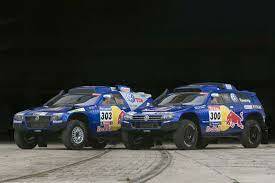

In the 2003 Dakar Rally, Volkswagen entered a team of rear wheel drive Tarek buggies. VW claimed sixth overall, driven by Stephane Henrard and co-driver Bobby Willis. In the following year, the 2004 Dakar Rally saw the debut rally for the T2 class purpose built Race Touareg by Volkswagen Motorsport. Bruno Saby and co driver Matthew Stevenson claimed sixth position overall. In the 2005 Dakar Rally, Jutta Kleinschmidt and co driver Fabrizia Pons claimed third spot overall in the Race Touareg.
In the 2006 Dakar Rally, Volkswagen driver Giniel de Villiers and co-driver Tina Thörner claimed second spot the highest ever for a diesel model in the new Race Touareg 2. It has a shorter wheelbase than the original Race Touareg, as well as increased visibility. For the 2007 Dakar Rally, VW driver Mark Miller and Ralph Pitchford drove the Race Touareg 2 to 4th position overall. In the 2008 Central Europe Rally, Carlos Sainz drove his Race Touareg 2 to victory. Finally, in the 2009 edition of Rally Dakar, Volkswagen achieved a one-two result. Giniel de Villiers and co driver Dirk von Zitzewitz won the race ahead of Mark Miller and Ralph Pitchford. With just two days to go, Carlos Sainz crashed out after dominating the rally for several days, thus preventing Volkswagen from making it a one-two-three result.
Carlos Sainz won in 2010 with a 1-2-3 finish, and Nasser Al-Attiyah won for VW in 2011.
A 1/32 slot car model of the Red Bull-sponsored Touareg, which is designed to run on the company's RAID track (which simulates off-road racing), is available from Ninco.
I.D. R


2018-2020
The Volkswagen I.D. R also known as Volkswagen I.D. R Pikes Peak, is a prototype fully electric vehicle designed as part of Volkswagen's I.D. Project, and included within Volkswagen's R series of cars designed specifically for competing in motorsport events. It is the first electric racing car designed by Volkswagen.
Following the Volkswagen emissions scandal in 2015, the company pulled out of motorsport events such as the World Rally Championship (which they had won every year since 2013), the Dakar Rally (3 straight wins since 2009) and the 24 Hours of Le Mans (13 wins with its Audi and Bentley brands in the 15 years prior to 2014).
The Volkswagen I.D. R made its competition début at the Pikes Peak International Hill climb in Colorado Springs, Colorado on 24 June 2018. It was driven by Romain Dumas, and the team set a target of beating the existing electric car record of 8:57.118 minutes, set in 2016 by Rhys Millen with the Drive eO PP100. The I.D. R became the first car to complete the hill climb in under eight minutes (7:57.148), breaking the outright record set by Sébastien Loeb and the Peugeot 208 T16 Pikes Peak. The average speed during the run was 150.9 km/h, and 218 km/h through the speed trap.
ID series
The Volkswagen ID. series is a family of battery electric cars from Volkswagen (VW), built on the MEB platform (German: Modularer E-Antriebs-Baukasten; English: modular electric-drive matrix) that is developed by the Volkswagen Group for a range of electric cars. Deliveries began in late 2020. By November of 2022, half a million vehicles have been delivered.
The ID. series is the first series of electric cars from VW that are purpose built from the ground up to be electric vehicles. Most of its production vehicles were adapted from several concept car models. According to Volkswagen, ID. stands for "intelligent design, identity and visionary technologies".

The Volkswagen ID.3 is a battery electric small family car (C-segment) produced by Volkswagen since 2019. It is the first production car to utilize the MEB platform, and the first model of the ID. series.
At launch, the European-market ID.3 was available with a choice of two models: "ID.3 Pro Performance" and "ID.3 Pro S". Both the Pro Performance and the Pro S shared the same APP 310 traction motor, which has an output of 204 PS. The difference was in the storage capacity of the battery.

The ID.4 is the second model of the Volkswagen ID. series. The production version of the ID.4 debuted in September 2020 as the first fully-electric crossover SUV under the Volkswagen brand, while the coupe-shaped variant of the ID.4 (akin to the Audi e-tron Sportback) is marketed as the Volkswagen ID.5 and was revealed in November 2021.
The ID.4 is positioned by Volkswagen as a high-volume, mass-market electric vehicle — a car for "the millions, not the millionaires," as the company claimed in its advertising.

The Volkswagen ID.6 is a battery electric mid-size crossover SUV with three-row seating produced by Volkswagen in China from 2021.
Two versions with different front and rear fascia styling is announced, which are the ID.6 Crozz produced by FAW-VW and the ID.6 X produced by SAIC-VW. The ID.6 is built on the VW Group MEB platform shared with the Volkswagen ID.4, Škoda Enyaq iV as well as the Audi Q4 e-tron.



The Volkswagen ID. Buzz is a battery electric minivan produced by German manufacturer Volkswagen. It is the first production electric minivan from Volkswagen.
According to product lead Jeffrey Lear, the styling of the ID. Buzz was chosen to "be modern and fresh and exciting for folks who may not have even been around [during the 1960s and 70s]" while retaining cues to the original Type 2 (T1)/Microbus, including the prominent front-mounted logo and (optional) two-tone paint.
id.7
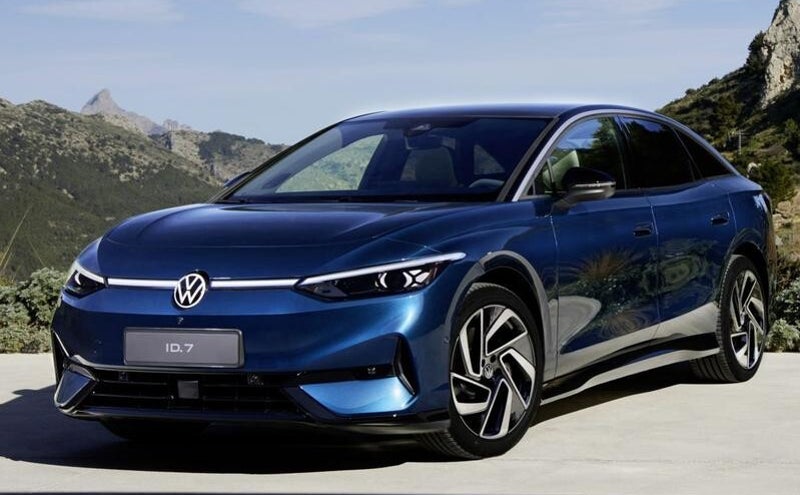
2023-present


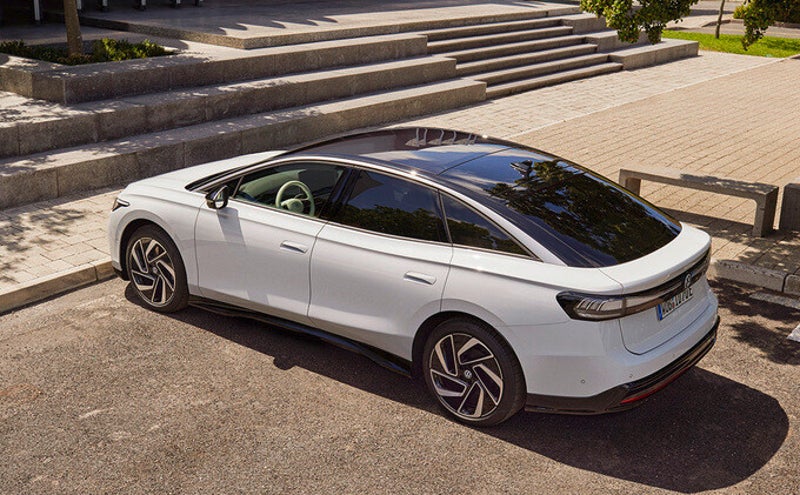
Following in the tire tracks of the electric ID.4 SUV and ID.Buzz minivan, Volkswagen will soon roll out the ID.7 sedan, a mid-size electric family four-door similar in size to the Passat. Based on the ID.Aero concept, the ID.7 is designed to be as aerodynamic as possible but, as we can see from the photos, it's also quite stylish. We expect it to offer both rear- and all-wheel-drive electric powertrains when it goes on sale as a 2025 model; its driving range should be around 700 km, which is slightly longer than the ID.4's. All models will come with a large 15.0-inch infotainment touchscreen and a head-up display that's capable of projecting navigation instructions as well as key info such as vehicle speed.
At launch, the ID.7 will come with a single electric motor driving the rear wheels with 282 horsepower. A dual-motor all-wheel-drive variant with more power is expected to join the lineup later on, but for now, this rear-wheel-drive setup should provide fairly perky acceleration. VW claims a 100 km/h acceleration time of 5.1 seconds.
adds in time



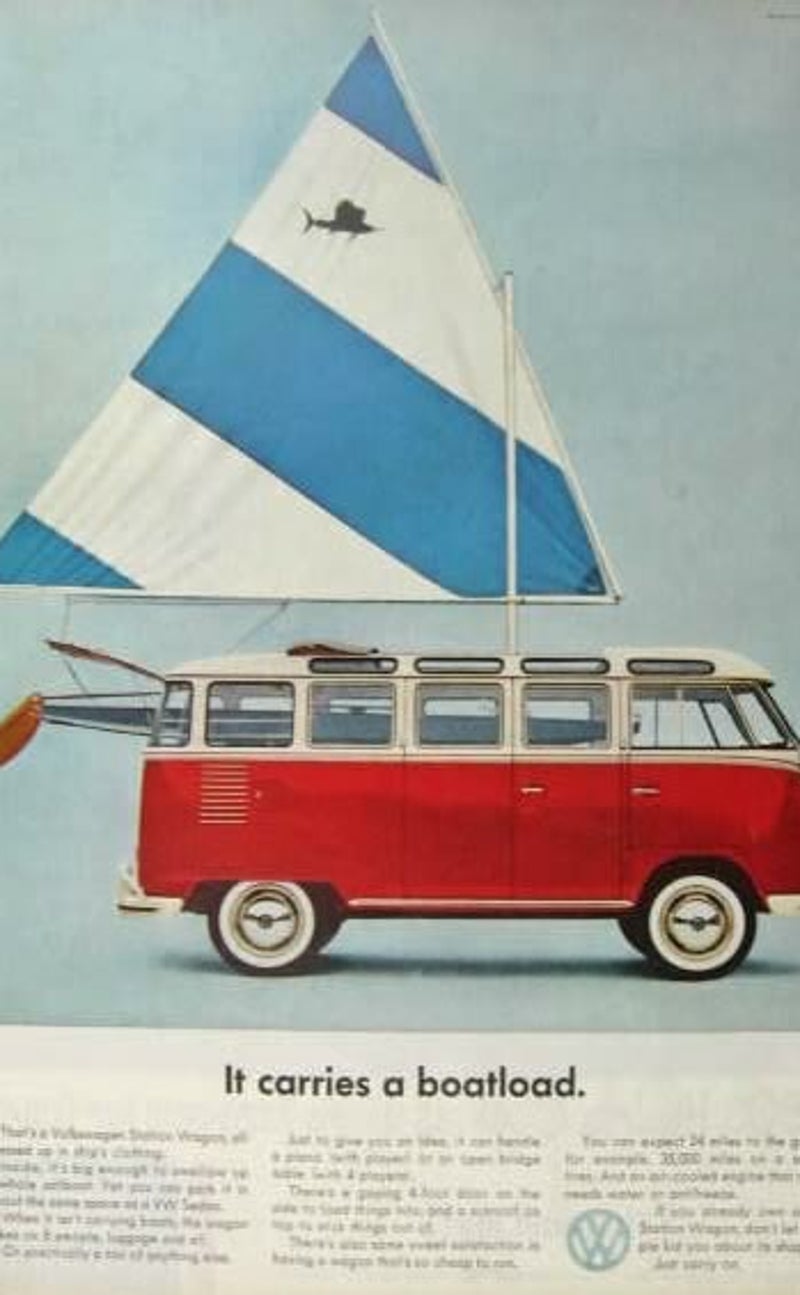






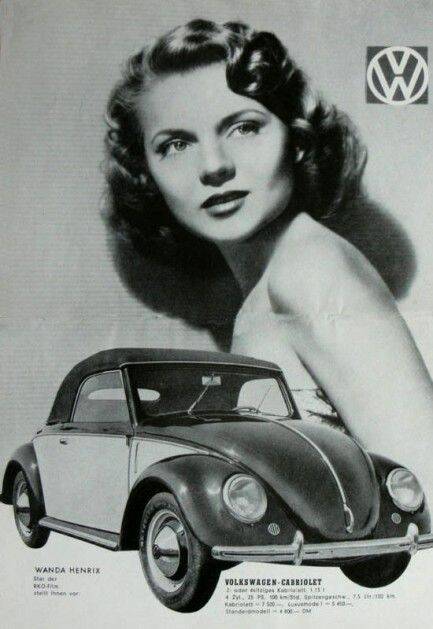

The Volkswagen Group sells passenger cars under the Audi, Bentley, Bugatti, Jetta, Cupra, Lamborghini, RUF, Porsche, SEAT, Škoda and Volkswagen marques; light commercial vehicles under the Volkswagen Commercial Vehicles brand; motorcycles under the Ducati brand; and heavy commercial vehicles via the marques of listed subsidiary Traton: MAN, Navistar, Scania and Volkswagen Caminhões e Ônibus. It is divided into two primary divisions—the Automotive Division and the Financial Services Division—and as of 2008, had about 342 subsidiary companies. Volkswagen also has two major joint ventures in China (FAW-Volkswagen and SAIC Volkswagen). The company has operations in roughly 150 countries and operates 100 production facilities across 27 countries.








Create Your Own Website With JouwWeb